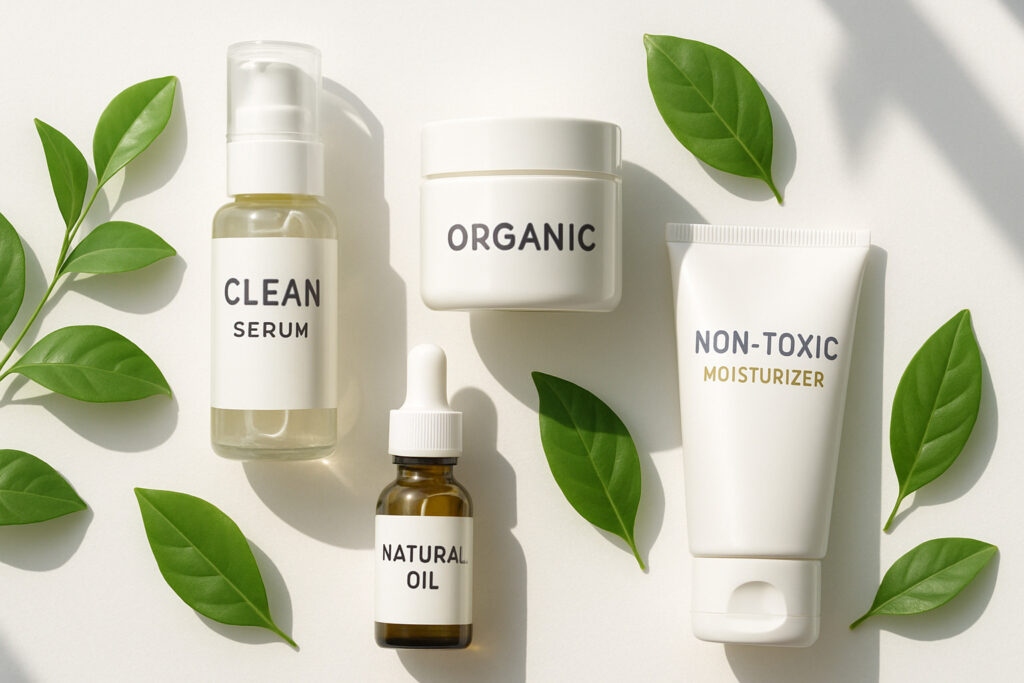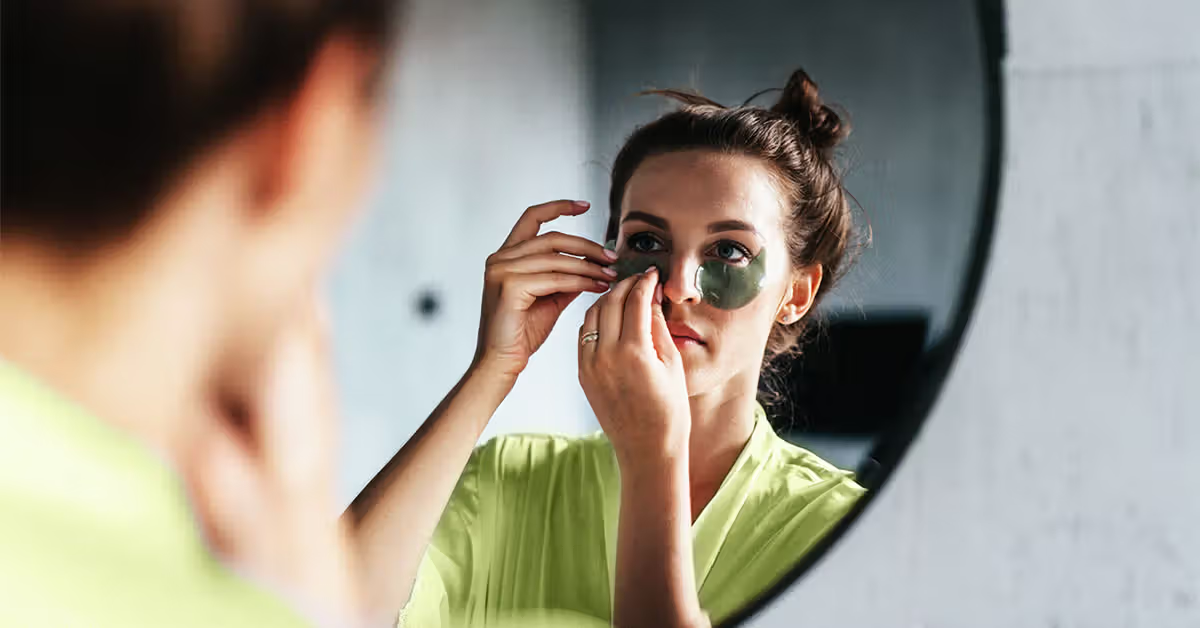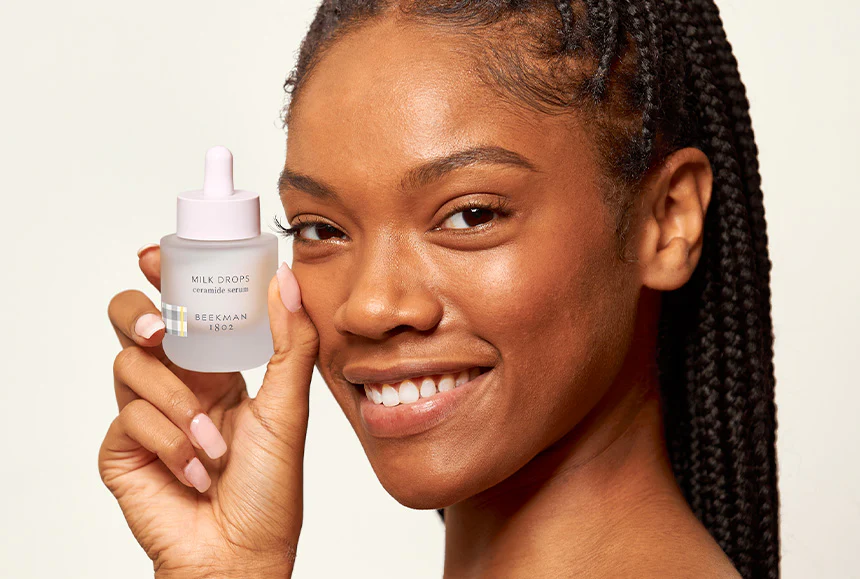The Truth About What’s In Your Skincare Products
Non-toxic skincare refers to beauty products formulated without ingredients linked to health concerns or environmental damage. If you’re looking for safe skincare products, here’s what you need to know:
- Non-toxic skincare excludes: parabens, phthalates, synthetic fragrances, formaldehyde releasers, and other potentially harmful chemicals
- Look for certifications: EWG VERIFIED, MADE SAFE, or Leaping Bunny logos
- Check ingredients: Always read full ingredient lists and avoid the “Toxic Twelve”
- Shop mindfully: Choose retailers and brands that publicly share strict ingredient standards and complete transparency
Imagine, for a moment, a world where every dab of moisturizer carries with it not just the promise of beauty, but of safety and respect for your body. This isn’t just a dreamit’s the foundation of the non-toxic skincare movement that’s changing how we think about our daily beauty routines.
“In an era where health and wellness are at the forefront of our daily lives, the demand for non-toxic skincare products has never been higher,” notes a leading clean beauty advocate. And for good reason.
While conventional skincare products often contain chemicals linked to hormone disruption, skin irritation, and even long-term health concerns, non-toxic alternatives prioritize ingredients that work with your body’s natural processes rather than against them.
The truth is sobering: in North America, there is no regulation defining what “natural” means on skincare labels. This allows brands to market heavily chemical-laden formulations with minimal genuine natural content. Meanwhile, the European Union has banned over 1,200 ingredients from cosmetics that are still permitted in U.S. products.
Your skin is your largest organ, absorbing much of what you apply to it. This makes the choice of what you put on your body just as important as what you put in it.
Whether you’re dealing with sensitive skin, concerned about environmental impact, or simply want products that deliver results without compromise, understanding non-toxic skincare is your first step toward healthier, more conscious beauty choices.

What Is Non-Toxic Skincare?
When we talk about non-toxic skincare, we’re referring to products created without ingredients that could harm your health. These are formulations that deliberately exclude chemicals linked to serious concerns like cancer, hormone disruption, and reproductive issues.
Think of non-toxic skincare as beauty with boundaries. While conventional products might contain questionable ingredients, non-toxic options follow stricter standards—often aligning with the European Union’s guidelines that have banned or restricted over 1,200 cosmetic ingredients. It’s quite sobering when you compare this to the United States FDA’s approach, which has only banned about 30 ingredients.
One of the most trusted ways to identify truly safe products is through certifications like the EWG VERIFIED® mark. This isn’t just a pretty logo—products earn this seal only after rigorous evaluation by toxicologists, chemists, and epidemiologists. There’s good news here too: over 2,500 EWG VERIFIED® products are now available, and that number keeps growing as more people prioritize safety in their beauty routines.
At Beyond Beauty Lab, we firmly believe beauty should never come at the cost of your health. Non-toxic skincare represents our commitment to formulations that honor both your body and our planet.
How non-toxic skincare differs from clean, green & natural
If you’ve ever stood in a beauty aisle feeling confused by all the buzzwords, you’re not alone! These terms often get tossed around interchangeably in marketing, but they actually mean different things:
Non-toxic specifically focuses on products free from ingredients linked to harmful health effects—this is about what’s not in your products.
Clean is a broader concept that usually includes non-toxic ingredients but also considers ethical sourcing and sustainability practices.
Green primarily looks at environmental impact and sustainability—how the product affects our planet.
Natural suggests ingredients derived from nature, but here’s the catch—there’s no regulatory definition! A product can claim to be “natural” with as little as 1% natural ingredients mixed with potentially harmful synthetics.
This terminology confusion creates what experts aptly call a “regulation gap.” Without standardized definitions, brands can make claims that leave consumers scratching their heads. As one industry insider put it, “These days it seems like you need a degree in chemistry to try and decipher the ingredient list on your skin care products.” This is precisely why understanding what non-toxic truly means matters so much.
For more clarity on regulations, you might find the European Commission’s information on cosmetics enlightening.
Benefits of non-toxic skincare for overall wellness
Switching to non-toxic skincare offers rewards that go far beyond just avoiding harmful chemicals:
Your hormones will thank you. Many conventional skincare ingredients like parabens and phthalates can throw your endocrine system out of whack. By choosing non-toxic alternatives, you help maintain your body’s natural hormonal balance.
Your skin will likely feel calmer. Without harsh synthetic fragrances and preservatives, non-toxic products are generally gentler, reducing the chances of irritation, redness, and those frustrating allergic reactions many of us know too well.
The environment benefits too. Non-toxic formulations typically break down more safely in our waterways. Everything you wash off eventually enters our ecosystem—choosing safer options helps protect aquatic life.
Perhaps most importantly, you’re making an investment in your long-term health. By minimizing daily exposure to potentially harmful chemicals, you’re taking a meaningful step toward your overall wellbeing.
The results speak for themselves. One Beyond Beauty Lab community member shared, “I’ve noticed a remarkable change in neck and facial wrinkles after using non-toxic face cream for a year.” Another told us, “By week one of nightly serum use, I had fewer breakouts and bouncy skin.”
These real experiences remind us that when it comes to skincare, what you don’t put on your skin can be just as important as what you do.
Why Switch? Health Risks of Conventional Ingredients

Have you ever flipped over your favorite moisturizer and wondered what all those long, unpronounceable ingredients actually do? The beauty industry has a concerning reality that many consumers aren’t aware of: conventional skincare products often contain ingredients that scientists have linked to serious health concerns.
When it comes to non-toxic skincare, understanding what you’re avoiding is just as important as knowing what you’re embracing. Let’s pull back the curtain on some troubling ingredients found in many bathroom cabinets.
Your body’s hormonal system is incredibly delicate, and certain chemicals can throw it off balance. Endocrine disruptors like parabens and phthalates can mimic your natural hormones, potentially interfering with reproductive health and development. Research has revealed that exposure isn’t equal across all populations – African Americans show 1.8 times higher diethyl phthalate levels than other groups, highlighting concerning disparities in chemical exposure.
The reproductive impacts can be especially troubling. One eye-opening study found that women who used hair oils or perms during childhood faced a 40% greater risk of early-onset periods – a known risk factor for breast cancer later in life. Synthetic fragrances, which often contain phthalates, are particularly problematic because companies aren’t required to disclose their specific ingredients, simply listing “fragrance” on labels.
Your skin’s natural barrier – its first line of defense – can suffer damage from harsh ingredients like sulfates. When this barrier becomes compromised, you might notice increased sensitivity, redness, and irritation that seems to worsen over time rather than improve.
Perhaps most concerning is the concept of bioaccumulation – how certain preservatives and chemicals can build up in your body’s tissues over extended periods. A striking example comes from a study of Dominican women using skin-lightening creams, who were found to have mercury levels in their urine 30 times higher than normal.
The problem of undisclosed ingredients makes informed choices nearly impossible. Research examining products marketed to Black consumers found that 84% of chemicals in hair products weren’t listed on labels at all. How can anyone make healthy choices when facing such significant information gaps?
Heavy metals like lead and formaldehyde releasers (preservatives that slowly release formaldehyde, a known carcinogen) appear in many conventional products, despite their well-documented health risks. Scientific research on synthetic fragrances continues to reveal concerning connections between these ingredients and various health issues.
At Beyond Beauty Lab, we believe your skin deserves better than potentially harmful ingredients. The switch to non-toxic skincare isn’t about following trends – it’s about making informed choices that respect your body’s long-term health. After all, what you apply to your skin deserves the same careful consideration as what you put on your plate.
Ingredients Spotlight: What to Avoid & What to Accept
Let’s talk about what actually goes into your skincare products—because knowing this can be truly empowering! Understanding which ingredients deserve a place in your routine and which ones to show the door is essential for navigating non-toxic skincare.

The “Toxic Twelve” you’ll want to skip
Have you ever flipped over a product and felt like you needed a chemistry degree to understand the label? You’re not alone! Let’s decode those troublemakers you’ll want to avoid.
Parabens lurk in many conventional products as preservatives. These sneaky chemicals (look for methylparaben or propylparaben on labels) can mimic estrogen in your body and have even been detected in breast cancer tissue. Not exactly what you want from your moisturizer!
Ever noticed “fragrance” listed on ingredients without any specifics? That single word can hide dozens of phthalates and other undisclosed chemicals. These plasticizers disrupt hormones and have been linked to reproductive issues—definitely not something you want absorbed into your skin daily.
The world of synthetic fragrances goes beyond just phthalates. These complex chemical cocktails are among the top causes of allergic skin reactions. When your beauty product gives you that “signature scent,” it might be delivering hundreds of undisclosed chemicals along with it.
Formaldehyde releasers like DMDM hydantoin might sound innocent enough, but they slowly leak formaldehyde (yes, the embalming fluid) onto your skin. Since formaldehyde is a known carcinogen, these preservatives deserve a hard pass.
Beach lovers, take note: oxybenzone in conventional sunscreens not only disrupts hormones but damages coral reefs so severely that places like Hawaii have banned it. Your skin and the ocean deserve better protection!
The remaining troublemakers include triclosan (an antibacterial that promotes resistance), DEA compounds (potential carcinogens), harsh sulfates that strip your skin’s natural protection, petroleum derivatives that may carry contamination risks, environmentally persistent siloxanes, nervous system-affecting toluene, and heavy metals that can cause serious health problems over time.
Star ingredients that power non-toxic skincare
Now for the good news! Nature (and some safe lab innovations) offers incredible ingredients that deliver beautiful results without health compromises.
Hyaluronic acid might sound chemical, but it’s actually a molecule naturally found in your skin. This hydration superstar holds up to 1000 times its weight in water—like a microscopic moisture reservoir for your skin! As we age, our natural levels decline, making this a perfect addition to non-toxic skincare.
I’m personally obsessed with niacinamide (vitamin B3) for its multi-tasking magic. It strengthens your skin barrier, calms inflammation, and helps fade dark spots without irritation. It’s like that reliable friend who shows up exactly when needed!
Mother Nature’s medicine cabinet offers incredible plant oils like jojoba, argan, and rosehip that nourish skin without clogging pores. Each brings its own special properties—jojoba mimics your skin’s natural sebum, while rosehip delivers vitamin C and regenerative benefits.
Squalane deserves special mention because it feels like giving your skin exactly what it wants. This stable, non-comedogenic moisturizer is similar to your skin’s natural oils, making it especially compatible with all skin types.
Other star performers include brightening vitamin C, soothing aloe vera, mineral-rich seaweed extracts, barrier-supporting ceramides, collagen-boosting peptides, and protective botanical extracts like green tea and chamomile.
At Beyond Beauty Lab, we’re particularly excited about innovative ingredients like chebula (an ayurvedic fruit extract with remarkable antioxidant properties) and sustainably sourced marine ingredients that deliver exceptional results without environmental harm.
The beauty of these safe alternatives is that they work with your body’s natural processes rather than against them. Your skin recognizes and knows how to use these ingredients, often making them more effective than their synthetic counterparts.
For a deeper dive into clean beauty terminology and ingredients, check out our comprehensive Ingredient Glossary where we break down everything you need to know in simple, straightforward language.
How to Verify & Shop Smart

When “clean” and “natural” claims appear on virtually every beauty product, how do you separate marketing hype from truly non-toxic skincare? Let’s cut through the confusion together with some practical guidance.
Using databases & apps to vet non-toxic skincare
Remember when shopping for skincare meant simply picking the prettiest packaging? Those days are behind us! Now we have powerful tools right at our fingertips.
The Environmental Working Group’s Skin Deep® database stands out as the gold standard for ingredient safety checking. Think of it as your personal skincare detective, with an impressive resume: it covers over 127,000 products across 6,000 brands and evaluates ingredients against nearly 60 toxicity databases. Products receive a simple 1-10 rating (1 being safest), making it easy to make informed choices on the spot.
For on-the-go shopping, the EWG’s “Healthy Living” mobile app lets you simply scan barcodes to instantly see safety ratings. I’ve personally used this while standing in store aisles, and it’s a game-changer!
Other helpful digital assistants include the Think Dirty App (with its intuitive “dirty meter”), CodeCheck (which considers both your health and environmental impact), and Detox Me (offering personalized recommendations to reduce chemical exposure).
One important tip: a product is only as good as its worst ingredient. Even products with “natural” splashed across the label might contain one or two problematic ingredients that compromise safety. This is why these verification tools are so valuable—they catch what marketing might hide.
Where to buy trusted non-toxic skincare products
Finding retailers that have already done some vetting work can save you tremendous time and mental energy when shopping for non-toxic skincare.
Specialty clean beauty retailers have become trusted gatekeepers in the industry. Many specialty stores enforce strict ingredient standards and maintain rigorous policies for everything they stock. Shopping at these specialty retailers means someone has already screened out many problematic ingredients before products even reach the shelves.
Health food stores like Whole Foods Market and local health co-ops typically apply more stringent standards to their beauty sections than conventional retailers. These can be great places to find smaller, conscientious brands.
For online shopping, the EWG Verified Products Shop offers products that meet their strictest criteria, while many brand websites provide detailed ingredient information and sourcing practices that go beyond what fits on a product label.
Don’t overlook farmers markets either! Local artisanal skincare makers often create products with simple, transparent ingredients and are usually happy to chat about exactly what’s in their formulations and why.
When browsing shelves or websites, keep an eye out for third-party certifications that add an extra layer of verification. EWG VERIFIED® and MADE SAFE® focus specifically on ingredient safety, while Leaping Bunny guarantees no animal testing. For those concerned about organic ingredients, look for USDA Organic or COSMOS Organic seals.
Here’s something that might surprise you: price doesn’t always correlate with safety. Some of the most affordable brands have excellent safety profiles, while certain luxury products might contain problematic ingredients hiding behind fancy packaging and marketing. This is why verification matters more than price point.
At Beyond Beauty Lab, we believe that making informed choices shouldn’t require a chemistry degree. With these tools and trusted retailers, finding genuine non-toxic skincare becomes less overwhelming and more empowering. For even more guidance on deciphering product labels, check out our in-depth guide on Beyond the Label: How to Read Clean Beauty Ingredients Like a Pro.
Building Your Non-Toxic Skincare Routine
Transitioning to a non-toxic skincare routine doesn’t have to feel overwhelming. In fact, taking it step by step often works best—giving your skin time to adjust and your wallet a chance to recover between purchases.

Think of building your non-toxic routine like creating a capsule wardrobe—start with versatile essentials that work hard for you. Begin with just three products: a gentle cleanser that removes impurities without stripping your skin, a nourishing moisturizer that supports your skin barrier, and (perhaps most crucial of all) a mineral sunscreen to protect your skin daily.
Once you’ve established this foundation, you can thoughtfully add targeted treatments based on your specific concerns. Maybe a vitamin C serum for that antioxidant glow, a gentle exfoliator to use once or twice weekly, or a hydrating mask for those self-care Sunday moments.
“I was shocked at how much my skin improved just by simplifying my routine and switching to non-toxic options,” shares one Beyond Beauty Lab reader. “Less really can be more when it comes to healthy skin.”
Patience is key—your skin needs time to adjust to new products. Always conduct a patch test by applying a small amount to your inner arm or behind your ear and waiting 24 hours before applying to your face. This simple step can save you from potential irritation or allergic reactions.
Non-toxic skincare for sensitive skin types
If your skin tends to react to everything under the sun, you’ll want to be especially thoughtful when selecting non-toxic skincare. Even ingredients that are perfectly natural can trigger reactions in sensitive individuals.
For those with reactive skin, fragrance-free formulations are your best friends—yes, even those with natural essential oils, which can be just as irritating as synthetic fragrances for some people. Look for products with minimal ingredient lists, as fewer ingredients means fewer potential irritants to contend with.
Focus on barrier-supporting ingredients like ceramides, fatty acids, and squalane, which help strengthen your skin’s natural protective layer. Gentle botanicals such as aloe vera, chamomile, and calendula can provide soothing relief without aggravating sensitivity.
Many people with sensitive skin find that their reactivity actually decreases over time after switching to non-toxic formulations. As one customer shared with us, “After years of redness and irritation, my skin finally calmed down when I stopped putting conventional products on it. It was like my skin could finally breathe.”
Budget vs luxury: crafting a routine that works
Good news: non-toxic skincare exists at every price point, from budget-friendly basics to luxurious splurges. The key is making strategic choices based on your priorities and resources.
If you’re watching your spending, focus on multi-tasking products that deliver multiple benefits—like a balm that works for face, lips, cuticles, and dry patches. These workhorses give you more bang for your buck. Solid formulations often last significantly longer than their liquid counterparts; some solid cleansers can provide up to 204 uses—that’s about six months of daily cleansing!
For those with more room in their beauty budget, invest wisely in leave-on treatments that stay on your skin rather than wash-off products. A serum or moisturizer with active ingredients will generally deliver more benefits than an expensive cleanser that rinses down the drain after 60 seconds.
When considering luxury products, think about cost-per-use rather than sticker price. That $65 treatment mask might seem expensive, but if it delivers noticeable results over 25 weekly applications, it could be more valuable than a $20 daily product that barely makes a difference.
“The most sustainable product is the one that works,” is something we often say at Beyond Beauty Lab. A cheaper product that sits unused because it doesn’t deliver results is ultimately a waste of both money and resources. Your perfect routine might include a mix of budget basics and strategic splurges—and that’s perfectly fine.
Looking to get started with a simple but effective routine? Check out our Clean Beauty Starter Kit for the essentials you actually need.
Frequently Asked Questions about Non-Toxic Skincare
Is “natural” the same as non-toxic skincare?
Not at all! This is one of the most common misconceptions I hear from people just starting their clean beauty journey.
The term “natural” sounds wonderful, doesn’t it? But here’s the truth: it has absolutely no regulated definition in the beauty industry. A product can contain just a drop of aloe vera mixed with a cocktail of potentially harmful synthetic ingredients and still proudly display “natural” on its label.
Non-toxic skincare, on the other hand, specifically focuses on avoiding ingredients linked to health concerns—regardless of whether those ingredients come from nature or a lab. Some lab-created ingredients like certain vitamin C derivatives can be perfectly safe and effective, while some completely natural plant extracts might trigger serious reactions in certain people.
As we often remind our readers at Beyond Beauty Lab, “In North America, there is no regulation defining what ‘natural’ means on skincare labels. This allows brands to market heavily chemical-laden formulations with minimal genuine natural content.”
The takeaway? Look beyond marketing buzzwords and focus on what’s actually in your products.
Do non-toxic products work as well as conventional formulas?
“Will I have to sacrifice results for safety?” I hear this concern all the time, and I’m thrilled to say the answer is a resounding no!
Today’s non-toxic skincare formulations can absolutely deliver the same—and sometimes even better—results than their conventional counterparts. The old notion that you need harsh chemicals for effectiveness is completely outdated.
The proof is in the results:
– Women aged 30-60 in clinical trials unanimously reported more luminous skin after using leading non-toxic facial oils
– Fine lines and wrinkles showed significant improvement in 100% of participants using non-toxic eye creams
– Every single participant experienced softer, smoother skin after just one week with non-toxic active serums
Many clean beauty brands now invest heavily in efficacy testing and advanced formulation technology. The key difference is they achieve these impressive results without ingredients linked to hormone disruption, irritation, or long-term health concerns.
As one Beyond Beauty Lab reader shared with us, “These clean products feel luxurious despite being chemical-free. The exfoliator is a miracle worker for a glow without going to a spa.” I couldn’t agree more!
Conclusion
The journey toward non-toxic skincare isn’t just about avoiding harmful ingredients—it’s about embracing a more thoughtful approach to beauty that honors both your body and our planet. Throughout this guide, we’ve seen how making informed choices about what goes on your skin can have profound effects on your health, wellbeing, and environmental footprint.
You don’t need to overhaul your entire routine overnight. Start small by replacing one product at a time, focusing first on leave-on items like moisturizers and serums that have the most prolonged contact with your skin. Use the resources we’ve shared—from the EWG Skin Deep database to certification guides—to steer your choices with confidence.
Many people report that their skin actually improves after switching to non-toxic options. As one of our readers shared, “My skin has never looked better since I made the switch. The redness I struggled with for years finally calmed down, and I feel good knowing I’m not putting anything harmful on my body.”
At Beyond Beauty Lab, we believe beauty should never come at the expense of health. We see the non-toxic movement not as a passing trend but as a fundamental shift in how we approach self-care—one that acknowledges the powerful connection between what we put on our bodies and how we feel.
“Beauty rituals should be moments of joy and nourishment,” as one formulator we admire puts it, “not sources of worry about potential harm.”
We invite you to continue exploring our resources at Beyond Beauty Lab as you deepen your non-toxic skincare journey.








